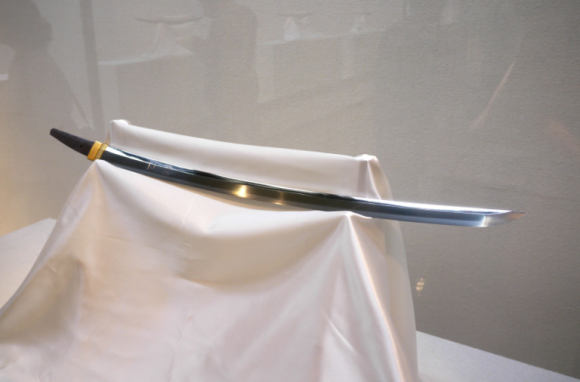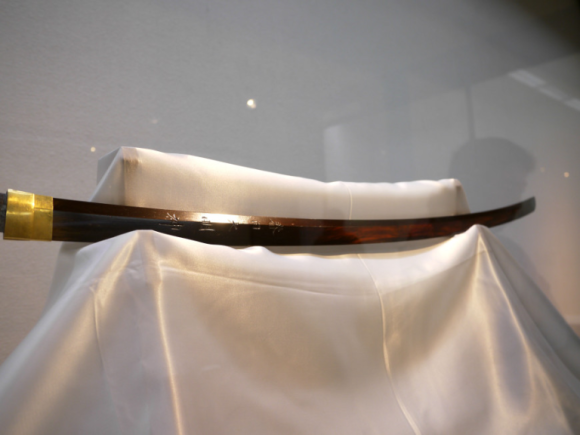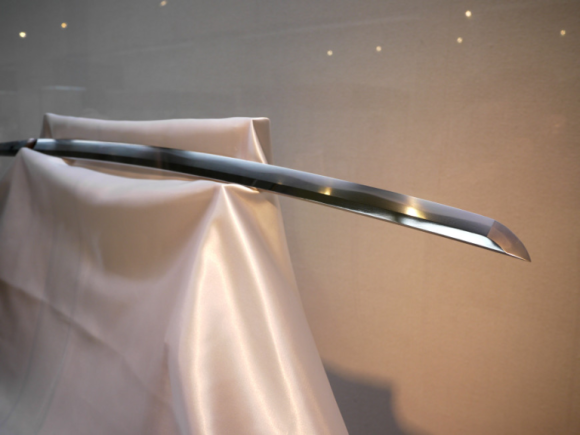
Want to make katana for a living? Hope you don’t mind not getting paid a single yen for the next five years.
Although it might sound unusual for artifacts with a centuries-long history, swords are currently in vogue in Japan. Museum exhibitions of historically significant katana have been attracting large, enthusiastic crowds in recent years, but the blades’ surging popularity is yet to solve a few problems.
In 1989, the Japanese Swordsmith Association counted 300 registered swordsmiths in the country. Not 20 years later, that number has been nearly cut in half, with only 188 smiths currently registered, and their average age rapidly increasing.
Swordsmithing isn’t just an industry, it’s also part of Japan’s cultural heritage. To preserve the craft, Tetsuya Tsubouchi, one of the Japanese Swordsmith Association’s directors, says two things have to be done. First, new swordsmiths have to be trained and certified to replace the craftsmen who’re retiring or otherwise being lost to old age, but there are some major hurdles in the way.
Not just anyone start hammering away and producing swords for sale in Japan. Practitioners are required to first serve as an apprentice under a registered swordsmith for a period of five years. These apprenticeships are unpaid, meaning that blacksmithing could be considered one of Japan’s harsh “black enterprises.” Those who want to complete the training must either burn through savings they amassed working in another field (before quitting that job to start their apprenticeship) or rely on financial support from their families. But while Japanese parents are generally willing to invest in their children’s education, it’s pretty difficult to convince Mom and Dad to cover all of your living expenses for a half-decade so that you can take a shot at making it in as niche an industry as swordsmithing. As a result, Tsubouchu says that though there’s actually been a recent uptick in apprenticeship applications, very few apprentices actually make it to the end of their five-year training period.
Even if they do complete their apprenticeship, prospective smiths still have to pass a national certification test, which takes place over a period of eight days. The test is offered only once a year, so if you fail, you’ve got a long wait until you get to take another swing at it. Oh, and once that’s all done, the estimated cost to set up a swordsmithing business of your own is 10 million yen (US$91,000), an amount of seed money that’s kind of hard to scrape together when your last paycheck was five years ago.
The other thing the industry needs, Tsubouchi says, is new customers. Collectors of art and antiquities have long been happy to buy and sell historical pieces, but a demand for preexisting blades isn’t creating much work for present-day smiths. What they need are people who’re interested in buying freshly forged swords, especially since they can7t just sell batches to the local samurai warlord like their predecessors in the feudal era did.
Luckily, a surge in popularity among sword-carrying anime and video game characters (some of which are actually swords themselves), as well as cosplayers dressed as those characters, has raised awareness of katana among young people, especially Japanese women, who’ve been showing a renewed interest in Japanese history in general over the past decade. Tsubouchi also points to collaborative efforts such as exhibitions that combine anime and katana aesthetics, such as a popular traveling display of swords inspired by the Evangelion franchise.
Tsubouchi also sees potential in the fact that rekijo, as Japan calls women with an interest in samurai history, range in age from teens up through women in their 30s and 40s. The director points out that in the past, it was often older, married men who wanted to buy katana to keep as family heirlooms, only to have the idea shot down as overly extravagant by the women of their household. But if both husband and wife, and maybe their daughter too, are keen on having a sword on display in the home, that purchase becomes a lot more justifiable.
The hope, Tsubouchi says, is not necessarily for new customers to convince people to buy ultra-premium pieces, but rather to cultivate a market for Japanese swords that are within the budget of even people who aren’t wealthy art collectors. He even muses about the possibility of reestablishing the largely forgotten custom of omamorigatana, in which swords were given as a good luck charm commemorating auspicious occasions such as births and marriages.
Still, with Japan placing so much importance on financial stability, it’s going to be an uphill battle encouraging people to seriously consider a career in swordsmithing, at least until there’s some solid evidence that all those people lining up to see swords at the museum would be genuinely willing to buy one for themselves.
Source: Yahoo! News Japan/Oricon News via Otakomu
Images ©SoraNews24




 Want to become a swordsmith? Apprenticeship opens in Japan, but the fine print might shock you
Want to become a swordsmith? Apprenticeship opens in Japan, but the fine print might shock you Amazing exhibition of Japan’s legendary “cursed katana” is going on right now【Photos】
Amazing exhibition of Japan’s legendary “cursed katana” is going on right now【Photos】 Japan’s legendary Brother Katana might not be brothers after all? Investigating the mystery【Pics】
Japan’s legendary Brother Katana might not be brothers after all? Investigating the mystery【Pics】 Missing 700-year-old national treasure katana found in Australia【Video】
Missing 700-year-old national treasure katana found in Australia【Video】 This hotel has one of the coolest katana collections in Japan, and admission is totally free【Pics】
This hotel has one of the coolest katana collections in Japan, and admission is totally free【Pics】 Starbucks Japan ready to get Year of the Horse started with adorable drinkware and plushies【Pics】
Starbucks Japan ready to get Year of the Horse started with adorable drinkware and plushies【Pics】 We found possibly the quietest Japanese-style hotel in Tokyo’s bustling Shinjuku district
We found possibly the quietest Japanese-style hotel in Tokyo’s bustling Shinjuku district 7 great places to see Mt. Fuji from without having to climb it
7 great places to see Mt. Fuji from without having to climb it Hello Kitty Choco Egg figures are an adorable trip through three periods of Japanese pop culture【Pics】
Hello Kitty Choco Egg figures are an adorable trip through three periods of Japanese pop culture【Pics】 Haunted hospital near Mt Fuji re-opens after renovation at Fuji-Q Highland, and it’s terrifying
Haunted hospital near Mt Fuji re-opens after renovation at Fuji-Q Highland, and it’s terrifying Japanese thug wear from Birth Japan perfect for those breaking bad next year
Japanese thug wear from Birth Japan perfect for those breaking bad next year Studio Ghibli fukubukuro: The lucky bag everyone in Japan wants to get their hands on at New Year
Studio Ghibli fukubukuro: The lucky bag everyone in Japan wants to get their hands on at New Year Godzilla-shaped ice cream on sale in Tokyo near the sight his most adorable rampage
Godzilla-shaped ice cream on sale in Tokyo near the sight his most adorable rampage Sushi restaurant’s crazy cheap lunch deal goes viral online
Sushi restaurant’s crazy cheap lunch deal goes viral online Is China’s don’t-go-to-Japan warning affecting tourist crowds in Tokyo’s Asakusa neighborhood?
Is China’s don’t-go-to-Japan warning affecting tourist crowds in Tokyo’s Asakusa neighborhood? Disillusionment at Tsukiji’s tourist-target prices led us to a great ramen restaurant in Tokyo
Disillusionment at Tsukiji’s tourist-target prices led us to a great ramen restaurant in Tokyo Japan may add Japanese language proficiency, lifestyle classes to permanent foreign resident requirements
Japan may add Japanese language proficiency, lifestyle classes to permanent foreign resident requirements Lacquerware supplier to emperor of Japan and Pokémon team up for new tableware
Lacquerware supplier to emperor of Japan and Pokémon team up for new tableware Starbucks Japan releases new zodiac chilled cup drink for 2026
Starbucks Japan releases new zodiac chilled cup drink for 2026 7-Eleven Japan’s ramen-cooking robot whipped us up a bowl of noodles【Taste test】
7-Eleven Japan’s ramen-cooking robot whipped us up a bowl of noodles【Taste test】 Cyberpunk anime meets traditional culture in Ghost in the Shell gold leaf Japanese changing screens
Cyberpunk anime meets traditional culture in Ghost in the Shell gold leaf Japanese changing screens Japan’s otoshidama tradition of giving kids money at New Year’s gets a social welfare upgrade
Japan’s otoshidama tradition of giving kids money at New Year’s gets a social welfare upgrade Japan’s human washing machines will go on sale to general public, demos to be held in Tokyo
Japan’s human washing machines will go on sale to general public, demos to be held in Tokyo 7-Eleven Japan starts new temporary luggage storage service in over 300 branches
7-Eleven Japan starts new temporary luggage storage service in over 300 branches Starbucks teams up with 166-year-old Kyoto doll maker for Year of the Horse decorations【Photos】
Starbucks teams up with 166-year-old Kyoto doll maker for Year of the Horse decorations【Photos】 Tokyo considering law requiring more trash cans following litter increase in heavily touristed area
Tokyo considering law requiring more trash cans following litter increase in heavily touristed area Tokyo’s Tsukiji sushi neighborhood asks tour groups to stay away for the rest of the month
Tokyo’s Tsukiji sushi neighborhood asks tour groups to stay away for the rest of the month Nintendo’s Kirby now delivering orders at Kura Sushi restaurants, but not in Japan
Nintendo’s Kirby now delivering orders at Kura Sushi restaurants, but not in Japan Tokyo event lets you travel back in time, for free, to celebrate 100 years since Showa era start
Tokyo event lets you travel back in time, for free, to celebrate 100 years since Showa era start Sanrio theme park in Japan announces plans to expand into a Sanrio resort
Sanrio theme park in Japan announces plans to expand into a Sanrio resort Stamina-destroying “Paralysis Noodles” are Tokyo’s newest over-the-top ramen innovation
Stamina-destroying “Paralysis Noodles” are Tokyo’s newest over-the-top ramen innovation Survey asks foreign tourists what bothered them in Japan, more than half gave same answer
Survey asks foreign tourists what bothered them in Japan, more than half gave same answer Japan’s deadliest food claims more victims, but why do people keep eating it for New Year’s?
Japan’s deadliest food claims more victims, but why do people keep eating it for New Year’s? We deeply regret going into this tunnel on our walk in the mountains of Japan
We deeply regret going into this tunnel on our walk in the mountains of Japan Studio Ghibli releases Kodama forest spirits from Princess Mononoke to light up your home
Studio Ghibli releases Kodama forest spirits from Princess Mononoke to light up your home Major Japanese hotel chain says reservations via overseas booking sites may not be valid
Major Japanese hotel chain says reservations via overseas booking sites may not be valid Put sesame oil in your coffee? Japanese maker says it’s the best way to start your day【Taste test】
Put sesame oil in your coffee? Japanese maker says it’s the best way to start your day【Taste test】 No more using real katana for tourism activities, Japan’s National Police Agency says
No more using real katana for tourism activities, Japan’s National Police Agency says The top 10 annoying foreign tourist behaviors on trains, as chosen by Japanese people【Survey】
The top 10 annoying foreign tourist behaviors on trains, as chosen by Japanese people【Survey】 Starbucks Japan reveals new sakura drinkware collection, inspired by evening cherry blossoms
Starbucks Japan reveals new sakura drinkware collection, inspired by evening cherry blossoms Dojigiri, the millennium-old katana said to have slain a demon, is now on display in Tokyo【Pics】
Dojigiri, the millennium-old katana said to have slain a demon, is now on display in Tokyo【Pics】 An A.I. program designed a katana, then a 15th-generation Japanese swordsmith made it【Photos】
An A.I. program designed a katana, then a 15th-generation Japanese swordsmith made it【Photos】 What’s so special about Japanese swords? We interview master katana maker Norihiro Miyairi!
What’s so special about Japanese swords? We interview master katana maker Norihiro Miyairi! How did samurai swords and armor evolve over time?【Part 2】【Photos】
How did samurai swords and armor evolve over time?【Part 2】【Photos】 Real-life Rurouni Kenshin reverse-blade katana, forged by master swordsmith, now on display【Pics】
Real-life Rurouni Kenshin reverse-blade katana, forged by master swordsmith, now on display【Pics】 Genuine Muramasa blade and Muromachi katana on display at Tokyo’s Touken Ranbu store【Photos】
Genuine Muramasa blade and Muromachi katana on display at Tokyo’s Touken Ranbu store【Photos】 Katana of four of Japan’s greatest samurai turned into gorgeous scissors
Katana of four of Japan’s greatest samurai turned into gorgeous scissors Sharpen your look with stylish Damascus steel watches modeled after Japanese blades
Sharpen your look with stylish Damascus steel watches modeled after Japanese blades Cool housewarming bonus: free Japanese katanas, potentially carved by a master craftsman
Cool housewarming bonus: free Japanese katanas, potentially carved by a master craftsman Historical katana dessert knives turn your sweet snacks into a delicious duel【Photos】
Historical katana dessert knives turn your sweet snacks into a delicious duel【Photos】 Legendary crescent moon katana, one of Japan’s Five Swords Under Heaven, now on display in Tokyo
Legendary crescent moon katana, one of Japan’s Five Swords Under Heaven, now on display in Tokyo One Piece anime katanas recreated as exquisite letter openers by Japan’s swordsmith legacy heirs
One Piece anime katanas recreated as exquisite letter openers by Japan’s swordsmith legacy heirs An up-close look at one of Japan’s five Ryuseito swords, forged from meteorites【Photos】
An up-close look at one of Japan’s five Ryuseito swords, forged from meteorites【Photos】 Swords of famous samurai reborn as beautiful kitchen knives from Japan’s number-one katana town
Swords of famous samurai reborn as beautiful kitchen knives from Japan’s number-one katana town Demon-slaying Dojigiri, one of Japan’s Five Swords Under Heaven, now on display at Kasuga Shrine
Demon-slaying Dojigiri, one of Japan’s Five Swords Under Heaven, now on display at Kasuga Shrine
Leave a Reply